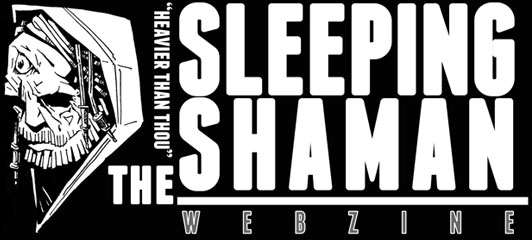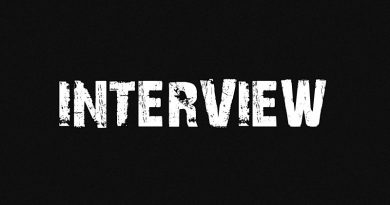H A R K: Dave Bowes Talks To Guitarist/Vocalist Jimbob Isaac From The UK’s Prog-Sludgers
It’s unfair to tag H A R K as Taint’s successor but, in a way, Jimbob Isaac’s prog-sludge trio is carrying on the work that Taint began, and gaining the success that his former home seemed bound for. Catching up with Jimbob after a (rather fine) set on their joint headlining tour with KEN mode, he took a few minutes out to stand in a cold, wet alley in Glasgow to discuss art, past achievements and H A R K’s progress thus far.
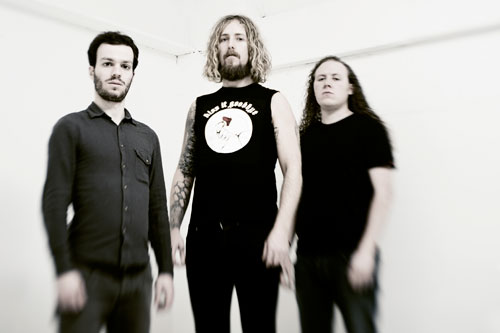
How has the current tour been so far? Is there much still to go?
Two more days, and that’s it; we will have done 24 shows in 25 days. It’s been pretty gruelling – two night drives in the first week, quite a few early starts and 8 or 9 hour drives and, because only four out of seven us have been sharing the driving, there’s been some pretty tired, burnt-out moments but when we get back it’ll feel like it was worth it. Tonight was good, though.
How does touring treat the band overall?
Very good. We were out in April and May with A Storm Of Light and it’s nice to see that our crowds have built since then, so we’ve been looking at an average of more people per night. People are getting their teeth into the album, which is cool, and we can see that in the crowd.
Crystalline’s been incredibly well-received, especially for a debut. Could you have expected a reaction like this?
No, we had no idea because this whole band was a gamble, and writing songs, getting to know each other has been a huge emotional and creative gamble. I suppose we were quietly confident that we honed the songs, because we wrote for two and a half years before releasing the 7”. No, we didn’t expect this but I suppose at the same time we thought that there was some chance it might get received somewhere near as well as it did.
Taint had such a devoted following, especially towards the end of the band’s run. Were the fans’ reactions towards H A R K reasonably positive?
People seem to have been reasonably positive about it. I think there’s always going to be a division into two camps – the Taint camp, and the H A R K camp, and some people sit in between and love both bands. I was talking about this with someone the other day, but times change, scenes change, people change and local environments all change, so when we’re touring now as H A R K, it’s hard to gauge things. I’ve certainly seen Taint people there because I’ve seen them wearing the T-shirts, but as a general thing, it’s just another time, and we’re in another phase. The economy is different, everything is different to ten years ago when Taint was touring, so it’s quite hard to gauge.
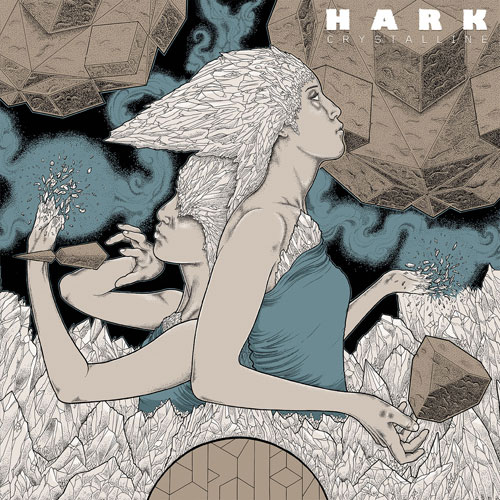
Even taking that on board, how have your own experiences been in H A R K compared to your time in Taint? I believe you’ve said that this offered more freedom.
I suppose so. Taint was such a long-running thing – I did it from 14 years old until I was 30, something like that. 16 years with Taint, from a boy to an adult, and the first songs we had were really wild, and fun, and stupid and chaotic. I think with H A R K, we’re taking it a bit more seriously. We’re approaching it as more of a professional band.
Creatively, I feel we can do a lot more now, especially in terms of rhythm, and drumming. Al from Taint has his own big, fat swing and his own groove. We really pushed him as far as he could go, I believe, and I think he would have to admit that, especially in terms in his commitment to the band, and to his drumming. I think we’re able to play all kinds of different stuff now.
You’ve certainly managed to establish this amazing marriage of technicality and complexity on one hand, and groove on the other. Do you place more importance on one than the other?
Basically, I’m always trying to strike that balance. I feel like I’ve got quite a good meter, or more like a radar, almost. When something is getting a little too complex and it loses feeling, I’ll call it out, or if something is really complex and cool but I like it, I’ll hold onto that and encourage us to take it into a more simplistic or groove-based direction. I feel personally like I am the one to always have that vision and make sure things aren’t going too far one way or the other. We all write together and contribute riffs, just like in Taint; the final song could never have been written by one person. I always want space and groove as much as I want complexity and asymmetry.
Are you working on new material at the moment or has touring taken up most of your time?
We have been concentrating more on touring this year but we already have one new song pretty much done and a ton of riffs. We’re going to get cracking on the writing stages for the next album. I’d like to see it released next year at some point.
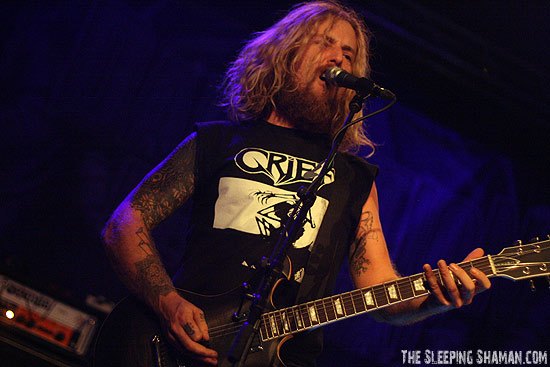
Was there much material left over after the recording of the last album, or was that more a case of cutting the wheat from the chaff?
We threw a lot of earlier stuff away anyway so Crystalline is the only material we had written to the point that we wanted it released. In some of the new material, there’re one or two riffs that were in that bucket that we might bring out but predominately it’s all been written since then.
One of the biggest shows that H A R K have done was at the first Temples Festival, which you also worked on the artwork for. Are you working on the art for the next Temples?
Yeah. The first illustration has only been hinted at on the trailer, where you can see little glimpses of it, but I’m just working on three main illustrations, a range of merch and of course, all the branding, web stuff, trailers – that’s all my work as well.
How much guidance do you prefer with commissioned pieces?
I’m open to some but when a client is so specific that it leaves me no room to do my thing, then I will lose interest. So I’m always open to initial ideas but I need some room.
So is there not much of a distinction in the composition of commissioned work and that for your own projects?
There is a difference and in some ways I’d like to close that gap, because my voice is still growing, visually. I’m a late starter because I drew until I was 15 years old, and then I studied and worked graphics for 16 years, but it’s only been in the last 6 years that I’ve started drawing again, so I’ve come full circle. I’m still using the same pens I was using when I was in college twenty years ago, so it’s really rewarding for me. I’m aware that my voice, my clientele and my presence generally is still building and developing but I feel I’m still in control enough to be able to pick and choose what I do and pick and choose the motifs that I then draw. Crystalline, as an example as you brought up, was very challenging. In terms of the logo and the 7” cover, that was done on the fly, kind of in the same way as Crystalline was as well. I took my age-old art nouveau influence, Alphonse Mucha. I know a lot of people are using him as an influence these days but that’s fine. If I belong to a club, that’s fine by me. I’ve been into him since I was 16 and, again, coming to use him as an influence, I feel is natural for me. Like I said, I belong to the club. Baizley and Beckett, all these guys, all good friends of mine, which is really cool; inspiring in terms of their workflow and their vision, but really my inspiration is Mucha since 1994, and all the comic books I read as a kid as well. So that’s where my genuine influence comes from.

What comic books did you read as you were growing up?
I liked some of the Dark Horse and some of the Marvel stuff – mainly McFarlane Spiderman in the 90s, and Terminator, Predator, Aliens for Dark Horse. I’m not an über-über-über-extensive comic book guy but I just had a few special ones. A lot of TMNT stuff as well, so I’m looking forward to the new movie as well.
You’ve said in interviews where the name of the band comes from, but what about the typography – H A R K? Is that just from a graphic design standpoint?
It is, simply that; just a lot of kerning between those letters. I chose the typeface, customised it and punched it up a bit. I just wanted that space between everything. I think it has a bit of gravitas to it. Unfortunately, a lot of people are unfamiliar with kerning, or they’re not used to looking at words with that much space between them, and they think that it’s an acronym, or perhaps an abbreviation. That’s fine, but I just see it as a logo, really, and that’s why we try to propagate the regular spelling, or regular writing, of it in other communications, and in press. It’s simply a word, but it’s from the logo design standpoint that we did that.
You just released a video for Scarlet Extremities. How did that come together?
Basically, our budget was limited, as you probably can imagine; we’ve got a friend in Wales called Jody Cusack who was able to shoot us in a really good quality one-day shoot. He had access to a white room studio and a black room, put together in a building, and a really good rig, and shot all the performance, which is the white room stuff, and the additional black room stuff in one day. We edited it with a bunch of psychedelic visual stuff that was acquired elsewhere. So, we did all the performance stuff, came up with a really simple, direct narrative, I did a quick storyboard in one afternoon, drew it out and wrote the story as I drew it and then Jody shot it, and then another one day a friend of ours added some after-effects, post-production stuff to it. It complements the album artwork, it complements some of the lyrical content and, with a limited budget and a simple idea, we’re pretty happy with it.
Have you done much work with animation yourself or have you ever considered branching out into that field?
I’ve done stuff within Timeline animation and Flash, stuff like that, when doing web design stuff, plus I’ve done some video editing. I think I’ve got a good eye for pace and visual rhythm, for example the Black Hole South West lyric video, which I edited, along with the trailer video for this tour, which I compiled live clips from the May tour for; just chop-chop-chop-chop… easy. I enjoy doing it, and it’s quite fun. In the same way that I will feed back to Kurt Ballou, going “this, this, change this and this” in the album mix, I sat with Jody in the edit suite to make sure the video had pace and flow and narrative flow. Maybe I’m a control freak but personally I feel I’ve got enough up there to handle these sorts of things. If you hand something over to somebody, you’re not always going to get what you hope for, so I try to be a polite Nazi. A Nazi gremlin, sitting on their shoulder.
With that in mind, is H A R K quite an egalitarian unit?
Yes. Well, we all contribute. In terms of certain aspects, I will maybe exert more creative control, but that will always be where the guys see it’s the right time for that, but when it comes to all kinds of other decisions, like logistic decisions, it’s different. Simon’s kind of the setlist orchestrator; we all contribute in different ways whenever we can. Power changes. I’ve seen other bands where one guy calls all the shots and those bands don’t work on a varied amount of levels for me, personally. I think there’s a good bit of give and take in all different areas.
Do you have any goals or aspirations for H A R K in the long run?
I think it’s good to have a healthy outlook in terms of short-term goals. If you let long-term goals dictate everything you do, you miss out on enjoying the present. We’d like to do certain things, we’d like to do more tours, we’d like to build more of a fan-base, ideally, but we know how important it is to balance home life and other facets of our lives to make sure that, if something happened to this band, then we could say, “Yeah, we gave it a go and now I can go and do this instead.” I think in this climate, that’s more realistic. We’re so far away from those early 90s where all these bands were getting pumped up and having money thrown at them, and it seems to me anyway that more than ever you need to have that DIY attitude now to survive. Be hands on with it. It’s not a controlling aspect but an involved aspect with an outside perspective to your band so that you can see where they stand and be realistic enough to survive.
Band Links: Official | Facebook | Bandcamp | Twitter
Interviewed by: Dave Bowes
Photo Credit: Ester Segarra (Promo) | Lee Edwards (Live)
